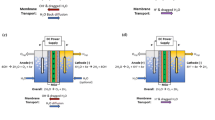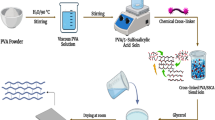Abstract
Improving the performance of forward osmosis (FO) membranes has always been moving forward. Here we fabricate the novel Turing structures in the active layer (AL) of thin film composite (TFC) membrane through effectively introducing the polyvinylpyrrolidone (PVP) macromolecule with hydrophilicity both in the support layer (SL) and AL. The addition of PVP facilitates the formation of sponge-like pores in the SL and stripe-like Turing structures in the AL. The influence of PVP on the morphology and performance of the membranes was investigated by SEM, AFM, XPS, NMR, FTIR. Compared with the water flux (Jw) of the original composite membrane (approximately 25 L m−2 h−1), TFC-PVP (3:1) membrane with Turing structure achieved better performance (approximately 75 L m−2 h−1), and the reverse solute flux/water flux (Js/Jw) value was as low as 0.02 g/L. This study demonstrated that the Turing structures have a favorable effect on the performance of FO membrane and a promisingly practical application in water treatment.
Graphic abstract













Similar content being viewed by others
References
Cath T, Childress A, Elimelech M (2006) Forward osmosis: principles, applications, and recent developments. J Membr Sci 281:70–87
Pendergast MM, Hoek EMV (2011) A review of water treatment membrane nanotechnologies. Energy Environ Sci 4:1946
Zhu J, Hou J, Zhang Y, Tian M, He T, Liu J (2018) Polymeric antimicrobial membranes enabled by nanomaterials for water treatment. J Membr Sci 550:173–197
Sun H, Zhang Y, Sadam H, Ma J, Bai Y, Shen X (2019) Novel mussel-inspired zwitterionic hydrophilic polymer to boost membrane water-treatment performance. J Membr Sci 582:1–8
Ding C, Zhang X, **ong S, Shen L, Yi M, Liu B (2020) Organophosphonate draw solution for produced water treatment with effectively mitigated membrane fouling via forward osmosis. J Membr Sci 593:117429
Li W, Li Y, Qi W, Chen J, Zhou W, Sun Y (2020) Effective removal of fluorescent microparticles as cryptosporidium parvum surrogates in drinking water treatment by metallic membrane. J Membr Sci 594:117434
Kedwell KC, Quist-Jensen CA, Giannakakis G, Christensen ML (2018) Forward osmosis with high-performing TFC membranes for concentration of digester centrate prior to phosphorus recovery. Sep Purif Techol 197:449–456
Chiao Y, Sengupta A, Chen S, Huang S, Hu C, Hung W (2019) Zwitterion augmented polyamide membrane for improved forward osmosis performance with significant antifouling characteristics. Sep Purif Techol 212:316–325
Wang X, Hou J, Chen F, Meng X (2020) In-situ growth of metal-organic framework film on a polydopamine-modified flexible substrate for antibacterial and forward osmosis membranes. Sep Purif Techol 236:116239
Elimelech M, Phillip WA (2011) The future of seawater desalination: energy, technology, and the environment. Science 333:712–717
Fang L, Cheng L, Jeon S, Wang S, Takahashi T, Matsuyama H (2018) Effect of the supporting layer structures on antifouling properties of forward osmosis membranes in AL-DS mode. J Membr Sci 552:265–273
Wang J, Xu R, Yang F, Kang J, Cao Y, **ang M (2018) Probing influences of support layer on the morphology of polyamide selective layer of thin film composite membrane. J Membr Sci 556:374–383
Lin L, Weigand TM, Farthing MW, Jutaporn P, Miller CT, Coronell O (2018) Relative importance of geometrical and intrinsic water transport properties of active layers in the water permeability of polyamide thin-film composite membranes. J Membr Sci 564:935–944
Zhang Z, Zhang S, Zhang Q, Dai L, Wang H, Li S (2017) Novel insights into the interplay between support and active layer in the thin film composite polyamide membranes. J Membr Sci 537:372–383
Corvilain M, Klaysom C, Szymczyk A, Vankelecom IFJ (2017) Formation mechanism of sPEEK hydrophilized PES supports for forward osmosis. Desalination 419:29–38
Suwaileh W, Johnson D, Khodabakhshi S, Hilal N (2019) Superior cross-linking assisted layer by layer modification of forward osmosis membranes for brackish water desalination. Desalination 463:1–12
Niksefat N, Jahanshahi M, Rahimpour A (2014) The effect of SiO2 nanoparticles on morphology and performance of thin film composite membranes for forward osmosis application. Desalination 343:140–146
Obaid M, Ghouri ZK, Fadali OA, Khalil KA, Almajid AA, Barakat NAM (2016) Amorphous SiO2 NP-incorporated poly(vinylidene fluoride) electrospun nanofiber membrane for high flux forward osmosis desalination. ACS Appl Mater Inter 8:4561–4574
Ghanbari M, Emadzadeh D, Lau WJ, Matsuura T, Davoody M, Ismail AF (2015) Super hydrophilic TiO2/HNT nanocomposites as a new approach for fabrication of high performance thin film nanocomposite membranes for FO application. Desalination 371:104–114
Rastgar M, Bozorg A, Shakeri A (2018) Novel dimensionally controlled nanopore forming template in forward osmosis membranes. Environ Sci Techol 52:2704–2716
Yang Z, Huang X, Ma X, Zhou Z, Guo H, Yao Z (2019) Fabrication of a novel and green thin-film composite membrane containing nanovoids for water purification. J Membr Sci 570–571:314–321
Ma N, Wei J, Qi S, Zhao Y, Gao Y, Tang CY (2013) Nanocomposite substrates for controlling internal concentration polarization in forward osmosis membranes. J Membr Sci 441:54–62
Zhang X, Liang S, Chen-Yu G, Chu-Xuan L, Wan-Zhong L, Wang Y (2018) Construction of SiO2@MWNTs incorporated PVDF substrate for reducing internal concentration polarization in forward osmosis. J Membr Sci 564:328–341
Myoung JP, Sherub P, Tao H et al (2015) Graphene oxide incorporated polysulfone substrate for the fabrication of flat-sheet thin-film composite forward osmosis membranes. J Membr Sci 493:496–507
Shen L, Hung W, Zuo J, Zhang X, Lai J, Wang Y (2019) High-performance thin-film composite polyamide membranes developed with green ultrasound-assisted interfacial polymerization. J Membr Sci 570–571:112–119
An Q, Hung W, Lo S, Li Y, De Guzman M, Hu C (2012) Comparison between free volume characteristics of composite membranes fabricated through static and dynamic interfacial polymerization processes. Macromolecules 45:3428–3435
Khorshidi B, Bhinder A, Thundat T, Pernitsky D, Sadrzadeh M (2016) Develo** high throughput thin film composite polyamide membranes for forward osmosis treatment of SAGD produced water. J Membr Sci 511:29–39
Horvath J, Szalai I, De Kepper P (2009) An experimental design method leading to chemical Turing patterns. Science 324:772–775
Lee MSY, Cau A, Naish D, Dyke GJ (2014) Sustained miniaturization and anatomical innovation in the dinosaurian ancestors of birds. Science 345:562–566
Tan Z, Chen S, Peng X (2018) Polyamide membranes with nanoscale Turing structures for water purification. Science 360:518–521
Yang Z, Guo H, Tang CY (2019) The upper bound of thin-film composite (TFC) polyamide membranes for desalination. J Membr Sci 590:117297
Zou S, Qin M, He Z (2019) Tackle reverse solute flux in forward osmosis towards sustainable water recovery: reduction and perspectives. Water Res 149:362–374
Arjmandi M, Peyravi M, Pourafshari Chenar M, Jahanshahi M (2019) A new concept of MOF-based PMM by modification of conventional dense film casting method: significant impact on the performance of FO process. J Membr Sci 579:253–265
Liang H, Hung W, Yu H, Hu C, Lee K, Lai J (2017) Forward osmosis membranes with unprecedented water flux. J Membr Sci 529:47–54
Qiu M, Wang J, He C (2018) A stable and hydrophilic substrate for thin-film composite forward osmosis membrane revealed by in situ cross-linked polymerization. Desalination 433:1–9
Akamatsu K, Suzuki M, Nakao A, Nakao S (2019) Development of hydrogen-selective dimethoxydimethylsilane-derived silica membranes with thin active separation layer by chemical vapor deposition. J Membr Sci 580:268–274
Obaid M, Ghouri ZK, Fadali OA, Khalil KA, Almajid AA, Barakat NAM (2016) Amorphous SiO2 NP-incorporated poly(vinylidene fluoride) electrospun nanofiber membrane for high flux forward osmosis desalination. ACS Appl Mater Interface 8:4561–4574
Choi Y, Hwang T, Jeong S, Lee S (2018) The use of ultrasound to reduce internal concentration polarization in forward osmosis. Ultra Sonoch 41:475–483
Acknowledgements
This study is financially supported by the Key Research and Development Plan of Tian** (20YFZCSN00430), the Key Research and Development Plan of Tian** (17YFNZNC00060), the Key Scientific and Technological Support Projects (No. 19YFZCSF01090), Huadian Aqua Membrane Separation Technology (Tian**) Co. Ltd. We would like to thank Editage (www.editage.cn) for English language editing.
Author information
Authors and Affiliations
Corresponding author
Ethics declarations
Conflict of interest
We declare that we have no financial and personal relationships with other people or organizations that can inappropriately influence our work.
Additional information
Handling Editor: Maude Jimenez.
Publisher's Note
Springer Nature remains neutral with regard to jurisdictional claims in published maps and institutional affiliations.
Electronic supplementary material
Below is the link to the electronic supplementary material.
Rights and permissions
About this article
Cite this article
Zhang, S., Liu, S., Ding, H. et al. An innovative strategy for improving the performance of forward osmosis membrane: stripe-like Turing structure constructed by introducing hydrophilic polyvinylpyrrolidone. J Mater Sci 55, 16482–16496 (2020). https://doi.org/10.1007/s10853-020-05151-y
Received:
Accepted:
Published:
Issue Date:
DOI: https://doi.org/10.1007/s10853-020-05151-y




